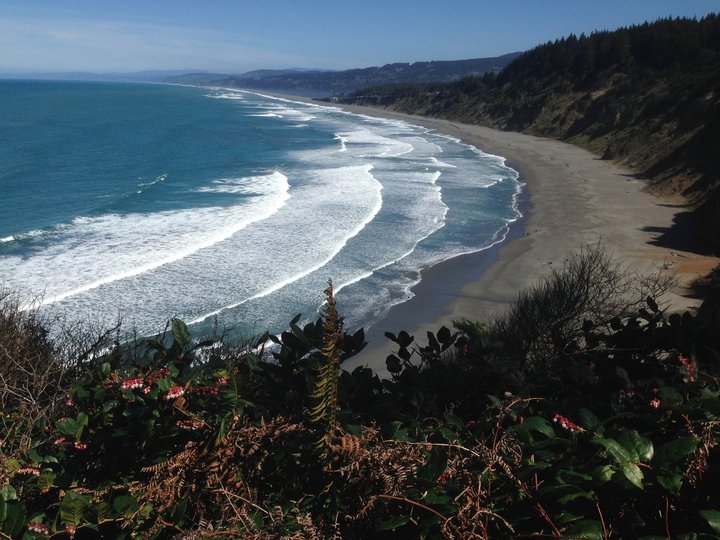
Agate Beach. Photo by Flickr user Alan Levine. Creative Commons License.
###
PREVIOUSLY:
- Coast Guard Conducting Rescue Efforts Near Big Lagoon
- (UPDATE) 8-Year-Old Child Airlifted to Hospital After Coast Guard Pulls Her From Surf Near Big Lagoon
- Eight-Year-Old Who was Swept Out to Sea Near Big Lagoon Has Died, HCSO Says
###
From the National Weather Service:
The National Weather Service and the Water Safety Coalition would like to remind community members that some beaches in Humboldt County are particularly dangerous because of how steep they are. Some of the steepest and most deadly beaches are found around the lagoons such as Big Lagoon, Dry Lagoon, and Freshwater Lagoon. In the past 15 years, 10 people have died on these beaches because they got too close to the water and were pulled into the surf. Other dangerous steep beaches around Humboldt County include Agate Beach at Patrick’s Point and Black Sands beach at Shelter Cove.
Steep beaches are deadly because they allow the full force of ocean waves to reach up onto the sand and strike with incredible speed and power. When this happens, the victim is pulled into the surf by the retreating wave. This can happen in the blink of an eye. It is very hard to resist the outrushing water because the loose coarse sand and steepness of the beach make it impossible to get a foothold. Once someone is pulled into the surf at these steep beaches it is practically impossible to escape because of the turbulent surf, raging rip currents, and numbing cold water. These beaches are also dangerous because the water gets very deep very quickly. Rising tides make steep beaches even deadlier.
Also remember that even if the ocean looks calm, a set of sneaker waves can strike without warning. Sneaker waves are hazardous at any beach but they are especially dangerous at steep beaches. For this reason, beach goers should stay far back from the water if they visit a steep beach.
If you do go to a steep beach, stay far away from the wet sand line, all the way up and over the point where the beach begins flatten out, and even as far back as where you start to see plants. This is especially true for children.
It is best to avoid steep beaches altogether. Instead, choose flatter beaches like Clam Beach or Moonstone Beach. Here is a summary of tips for staying safe at the beach.
Before heading to the beach. Check www.weather.gov/eureka to determine when the high tides are occurring and for ocean hazards. Remember rising tides make steep beaches and sneaker waves even more dangerous.
Choose your beach well. Steep beaches are particularly dangerous because the force of the ocean waves can reach much farther up the beach and pull you into the surf. Steep beaches also have coarse sand that washes out from under your feet and pull of the withdrawing water makes it hard to resist being pulled into the water. Some of the steepest beaches are at Big Lagoon, Dry Lagoon, and Freshwater Lagoon. Flatter beaches are better choices.
Sneaker Waves. Sneaker waves are a set of waves that seem to come out of nowhere. Sneaker waves can catch you off guard and quickly pull you into the ocean where survival is difficult because of strong currents, turbulent surf, and cold water that causes your arms and legs to loose strength within minutes. Don’t be fooled by an ocean that looks calm: There can be 30 minutes of small waves right before a sneaker wave strikes.
Avoid Rocks and Jetties. Rocks and jetties can give a false sense of security but sneaker waves can overtop them without warning.
Keep children back from the surf. Northern California beaches are prone to sneaker waves any time of year, so keep children far back from the surf. There is not enough time to move them to safety once a set of sneaker wave strikes. If you want to let children play right near the ocean then consider beaches inside Humboldt Bay.
Stay Back. Stay much farther back from the water than you might think is necessary. Sneaker waves can run up the beach 100 yards farther than the smaller waves that precede them. Also avoid walking near or on logs and debris since these waves can roll them over and onto you. And remember that rising tides can cause sneaker waves to wash even farther up a beach, and can cut off access around headlands.
Never turn your back on the ocean. The most dangerous thing you can do is to be near the surf with your attention diverted. If you participate in an activity that requires you to do this, such as surf fishing, consider wearing a life vest so you have a chance of surviving if you do get pulled into the surf.
Don’t go in after your dog. Dogs that are pulled into the surf almost always get out on their own while their human rescuers usually do not. If a dog goes into the water, stay on dry land and wait for them to swim back to shore. Remember: Don’t go in, Let them swim.
Call 911. Don’t go into the water after a person who is pulled into the surf. You will likely get in trouble so rescuers will have to divide their time between multiple victims. Call 911 and keep track of the person’s location in the water so you can guide rescuers to the person in trouble.
Share this message. Share this water safety message with your family, especially children, and with friends and co-workers. Even engage perfect strangers if you see them doing something dangerous.
The goal of the above information is not to scare people away from visiting our region’s beautiful beaches, but instead to help them select a safe beach and to stay safe at any beach.
CLICK TO MANAGE